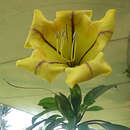en
names in breadcrumbs


Solandra grandiflora, the showy chalicevine, or papaturra[1] is a member of the nightshade ( Solanaceae ) genus Solandra and, like the other members of the genus, is a climbing plant with large, attractive, trumpet-shaped flowers. It is native to Central America and northern South America and is widely grown in the tropics as an ornamental.[2] The green parts of the plant are highly toxic (hallucinogenic / delirient in small doses), due to tropane alkaloid content,[3] and have caused deaths from anticholinergic poisoning,[4] but the flesh of the ripe fruit ( although not the unripe fruit or seeds ) is said to be edible. The fruits, which are globular and largely enclosed by the accrescent calyces, can reach a kilogram in weight and have a taste described as apple-like or melon-like.[2]
Symptoms caused by ingestion of plant parts - even from chewing fragments of flowers - include dryness of throat, headache, weakness, fever, delirium, hallucinations and potentially fatal circulatory and respiratory failure.[5]
Solandra grandiflora, the showy chalicevine, or papaturra is a member of the nightshade ( Solanaceae ) genus Solandra and, like the other members of the genus, is a climbing plant with large, attractive, trumpet-shaped flowers. It is native to Central America and northern South America and is widely grown in the tropics as an ornamental. The green parts of the plant are highly toxic (hallucinogenic / delirient in small doses), due to tropane alkaloid content, and have caused deaths from anticholinergic poisoning, but the flesh of the ripe fruit ( although not the unripe fruit or seeds ) is said to be edible. The fruits, which are globular and largely enclosed by the accrescent calyces, can reach a kilogram in weight and have a taste described as apple-like or melon-like.
Solandra grandiflora, la grande solandre ou liane trompette[2], est une espèce de plantes dicotylédones de la famille des Solanaceae, sous-famille des Solanoideae, originaire des régions tropicales d'Amérique.
C'est une plante ligneuse grimpante, au feuilles persistantes, qui peut atteindre 12 mètres de haut. Elle est toxique du fait de la présence dans tous ses organes d'alcaloïdes tropaniques (atropine, hyoscyamine, scopolamine)[3].
La grande solandre est cultivée comme plante ornementale dans les jardins tropicaux (elle ne résiste pas au gel), ou parfois comme plante d'intérieur, pour ses grandes fleurs parfumées et sa floraison abondante.
L'espèce Solandra grandiflora a été décrite en premier par le botaniste suédois Olof Peter Swartz et publiée en 1787 dans Kongl. Vetenskaps Academiens Nya Handlingar[4]. C'est l'espèce-type du genre Solandra.
Selon The Plant List (20 septembre 2020)[1] :
Selon The Plant List (20 septembre 2020)[1] :
Selon Tropicos (20 septembre 2020)[5] (Attention liste brute contenant possiblement des synonymes) :
L'aire de répartition originelle de Solandra grandiflora s'étend du Mexique au Brésil, englobant les pays suivants : Brésil, Costa Rica, Cuba, Salvador, Guatemala, Honduras, Jamaïque, Mexique, Nicaragua, Panama, Porto Rico, Trinité-et-Tobago, Venezuela. L'espèce a été introduite en Équateur et au Maroc[6].
Solandra grandiflora, la grande solandre ou liane trompette, est une espèce de plantes dicotylédones de la famille des Solanaceae, sous-famille des Solanoideae, originaire des régions tropicales d'Amérique.
C'est une plante ligneuse grimpante, au feuilles persistantes, qui peut atteindre 12 mètres de haut. Elle est toxique du fait de la présence dans tous ses organes d'alcaloïdes tropaniques (atropine, hyoscyamine, scopolamine).
La grande solandre est cultivée comme plante ornementale dans les jardins tropicaux (elle ne résiste pas au gel), ou parfois comme plante d'intérieur, pour ses grandes fleurs parfumées et sa floraison abondante.
Solandra (Solandra grandiflora) är en art inom familjen potatisväxter som förekommer naturligt på Jamaica, Puerto Rico och på de Små Antillerna. Arten odlas som trädgårdsväxt i varmare klimat och kan även odlas i växthus i Sverige.
Solandra är en klättrande buske eller lian som kan bli 10 meter eller mer. Bladen är elliptiska till omvänt äggrunda, till 18 cm långa, spetsiga. Bladskaftet blir cirka 2,5 cm långt. Fodret är tvåflikigt och ca 8 cm långt, det täcker i princip den smala delen av kronan, pipen. Kronan är femflikig och blir 10-15 cm lång. Den är bägarlik, något smalare just innan flikarn, med en lång blompip. Färgen är först vit, den växlar till gult eller brungult på andra dagen.
Solandra är mycket lik kubansk solandra (S. longiflora) som dock har ett foder som är hälften så långt som kronans pip. Solandra har ett foder som täcker i princip hela pipen.
Solandra (Solandra grandiflora) är en art inom familjen potatisväxter som förekommer naturligt på Jamaica, Puerto Rico och på de Små Antillerna. Arten odlas som trädgårdsväxt i varmare klimat och kan även odlas i växthus i Sverige.
Solandra är en klättrande buske eller lian som kan bli 10 meter eller mer. Bladen är elliptiska till omvänt äggrunda, till 18 cm långa, spetsiga. Bladskaftet blir cirka 2,5 cm långt. Fodret är tvåflikigt och ca 8 cm långt, det täcker i princip den smala delen av kronan, pipen. Kronan är femflikig och blir 10-15 cm lång. Den är bägarlik, något smalare just innan flikarn, med en lång blompip. Färgen är först vit, den växlar till gult eller brungult på andra dagen.
Solandra är mycket lik kubansk solandra (S. longiflora) som dock har ett foder som är hälften så långt som kronans pip. Solandra har ett foder som täcker i princip hela pipen.
Solandra grandiflora là loài thực vật có hoa trong họ Cà. Loài này được Sw. miêu tả khoa học đầu tiên năm 1787.[1]
Solandra grandiflora là loài thực vật có hoa trong họ Cà. Loài này được Sw. miêu tả khoa học đầu tiên năm 1787.